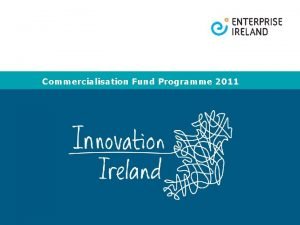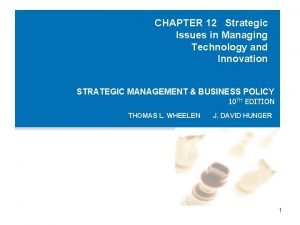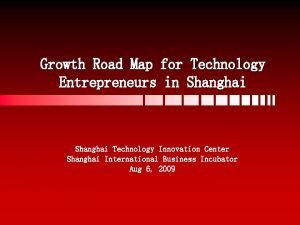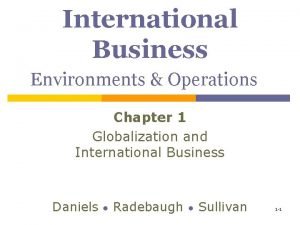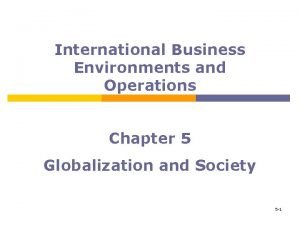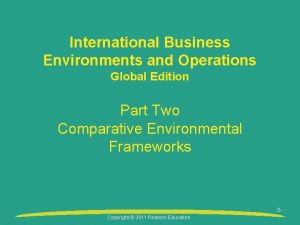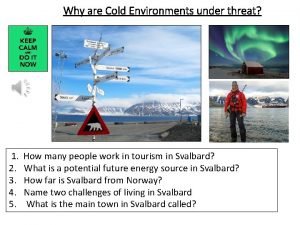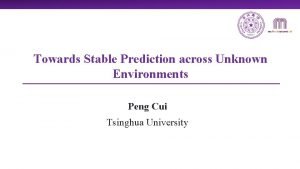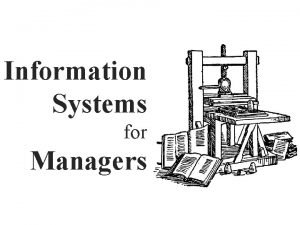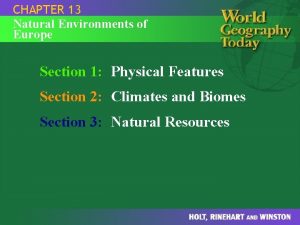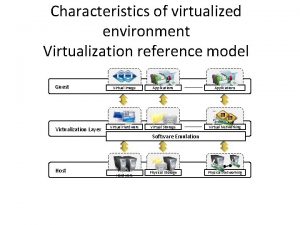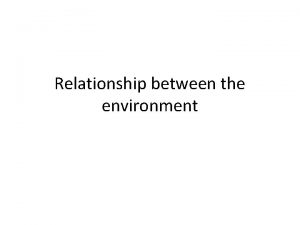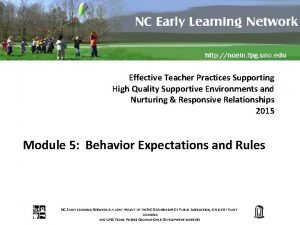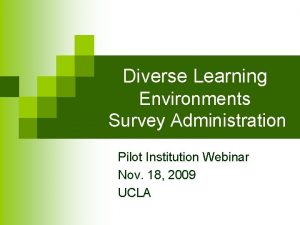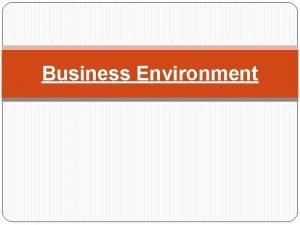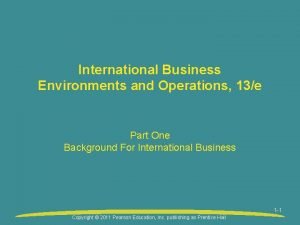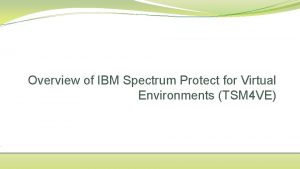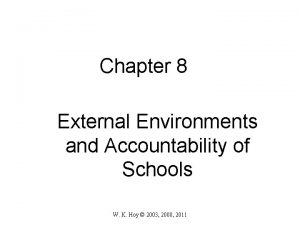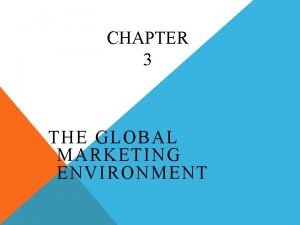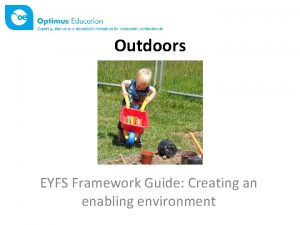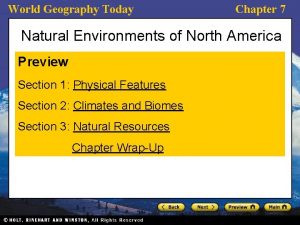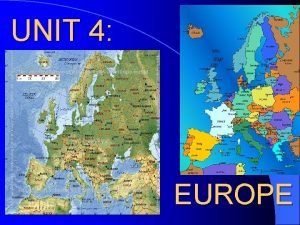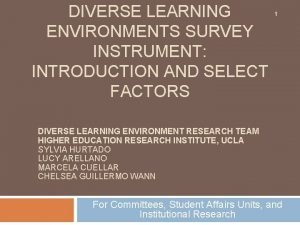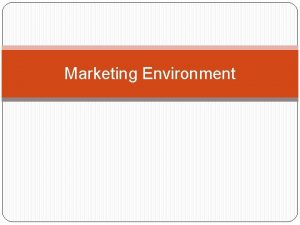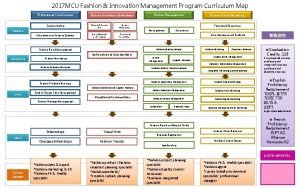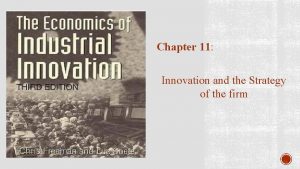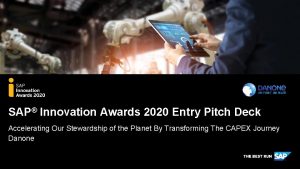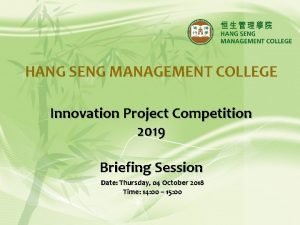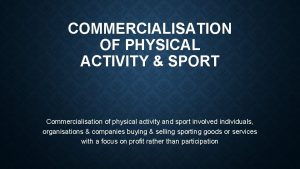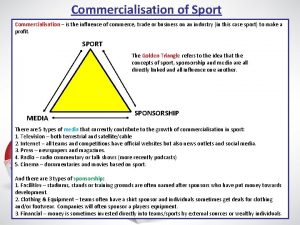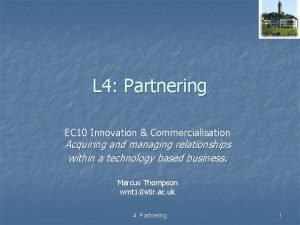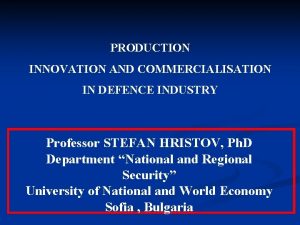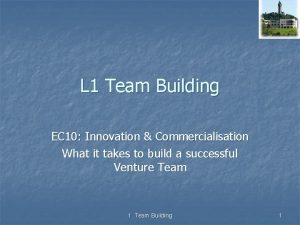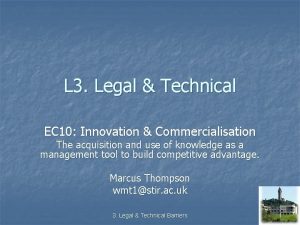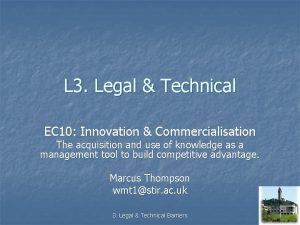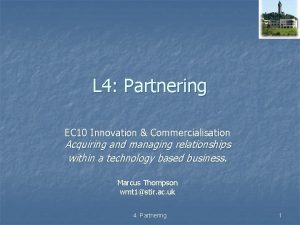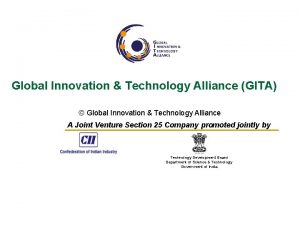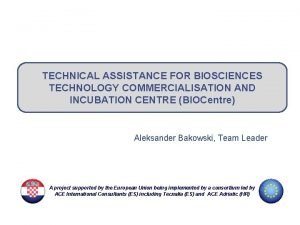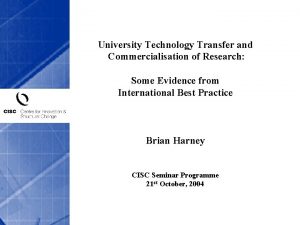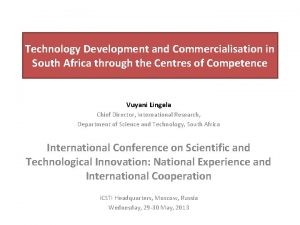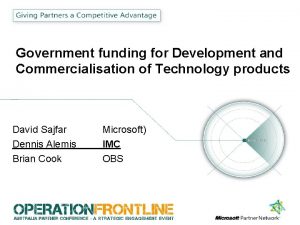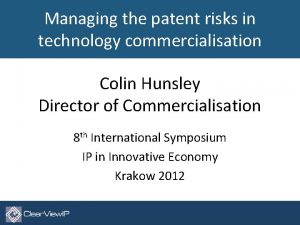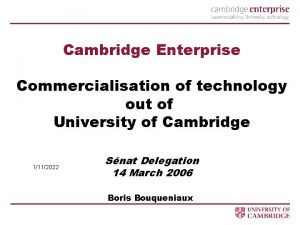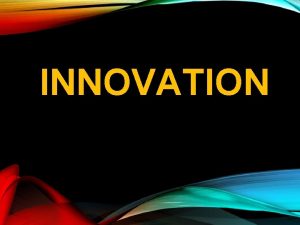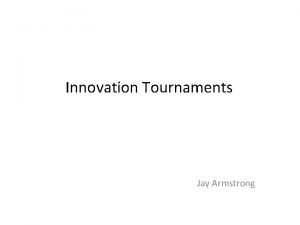L 7 Technology Environments EC 10 Innovation Commercialisation








































- Slides: 40

L 7 Technology Environments EC 10: Innovation & Commercialisation Conducting business in the global economy and playing to win Marcus Thompson wmt 1@stir. ac. uk 7. Technology Environments 1

Outline to Technology Environments The International Business Environment n Organisational & Supply Chain Development n Drucker on Innovation n Changing the World n 7. Technology Environments. L 7: Techn 9 ology Environments 2

1. The International Business Environment EC 10 Innovation & Commercialisation 7. Technology Environments 3

International Business: Opportunity and Conflict Globalization creates wealth and benefits Critics say it increases the wealth of corporations and investors at the expense of the poor and does other damage to society in general. Failure to become part of the global market assures a nation of declining economic influence and a deteriorating standard of living. 7. Technology Environments. L 7: Technology Environments: 4

MOTIVES FOR INTERNATIONALIZATION INTERNAL DRIVERS: – Search for Growth – Exploitation of opportunity EXTERNAL DRIVERS – Technology’s effects on customers/firms – The industrial context 7. Technology Environments. L 7: Technology Environments: 5

1. Information Requirement Preliminary Screening – Estimating Market Potential Income Elasticity of Demand Market Audit Analogy Longitudinal Analysis Gap Analysis These same issues apply regardless of whether a study is undertaken on or offline. – Estimating Sales Potential Identifying Segments Selection – Concentration versus Diversification 7. Technology Environments. L 7: Technology Environments: 6

2. Selection Issues Factors to take into Account Market-Related Factors Mix-Related Factors Company-Related Factors Market Matches Market-Related Factors Mix-Related Factors Company-Related Factors 7. Technology Environments. L 7: Technology Environments: 7

Innovation Linkages Science & Technology Base Technological Developments Needs of Market “Innovation occurs through the interaction of the science base, dominated by the Universities, technological developments dominated by industry and the needs of the market. (Trott 2002) 7. Technology Environments. L 7: Technology Environments: 8

2. Growth Options EC 10 Innovation & Commercialisation 7. Technology Environments 9

Strategy & Structure: Chandler’s contribution Key points from Chandler’s research: – Chandler concluded that strategy came before organisation structure – Increased decentralisation: organisations that become more diverse in their products and markets, need to reorganise and probably devolve power – Means the centre can no longer make the relevant decisions. 7. Technology Environments 10

Strategy or Structure: Williamson u u u Williamson explored the role of the centre as organisations became more diverse. His observations: – The role of the a firm’s senior managers (HQ) was to allocate resources between its various divisions and then monitor and control them – The strategy of the firm needed to be resolved first, with the organisational structure to follow According to Williamson, strategy came before structure in a firm. 7. Technology Environments 11

Fit between strategy & structure u u For a firm to be economically effective, there needs to be a match between the firm’s strategy and its structure: (the concept of strategic fit and or congruency) Firms need to adopt an internally consistent set of practices in order to undertake a proposed strategy. Such practices go beyond organisation structure into other related areas of the business. These areas include: the strategic planning process, recruitment and training, reward systems, knowledge, information systems and processes. 7. Technology Environments 12

Forms of Organisation u Bureaucratic, hierarchical u Flat structure, few management layers u Team-oriented structure u Matrix structure with a combination of vertical and horizontal authority u Product or service-oriented structures 7. Technology Environments 13

The Functional Structure Board Production u u u Main features Sales & marketing – Organised around tasks – Centralised u Accountancy Limitations Personnel – Succession problems – Unlikely to be entrepreneurial or adaptive Situations where appropriate – Profit responsibility exclusively with – Small companies, few plants, CEO limited products – Relatively stable – repetitive tasks – Become stretched by growth – Functional Managers may concentrate Advantages on short term routine activities at – Controlled by strategic expense of longer-term strategic leader/CEO] developments – Efficient – Problems of ensuring co-ordination between functions – rivalry may – Clearly delineated external develop relationships – Specialist managers – Functional specialist may seek to build mini-empires – Simple line of control – Can promote competitive 14 7. Technology Environments advantage through functions

The Entrepreneurial Structure u Main Features u Situations where appropriate – Organised around the entrepreneur – Totally centralised; no division responsibility Entrepreneurial Manager – Simple companies in early stages of Employee development u Advantages u Limitations Employee – Enables the founder, who logically understands the business to control its early growth and development. – The founder may not have sufficient specialist knowledge – Only appropriate to a certain size 7. Technology Environments 15

3. Organisational Development EC 10 Innovation & Commercialisation 7. Technology Environments 16

The Effective Organisation § The strategic purpose of the organisation § Its mission, vision and values § Customer characterisation and requirements § The culture and environment of the organisation 7. Technology Environments 17

Strategy & Structure § The organisation's mission and strategy drive the structure § The culture and environment of the organisation plays a large role in determining structure. § Informal and formal structures need to be aligned 7. Technology Environments 18

Strategy & Structure: Chandler’s contribution Key points from Chandler’s research: – Chandler concluded that strategy came before organisation structure – Increased decentralisation: organisations that become more diverse in their products and markets, need to reorganise and probably devolve power – Means the centre can no longer make the relevant decisions. 7. Technology Environments 19

Strategy or Structure: Williamson § Williamson explored the role of the centre as organisations became more diverse. § His observations: – The role of the a firm’s senior managers (HQ) was to allocate resources between its various divisions and then monitor and control them – The strategy of the firm needed to be resolved first, with the organisational structure to follow § According to Williamson, strategy came before structure in a firm. 7. Technology Environments 20

Fit between strategy & structure § For a firm to be economically effective, there needs to be a match between the firm’s strategy and its structure: (the concept of strategic fit and or congruency) § Firms need to adopt an internally consistent set of practices in order to undertake a proposed strategy. § Such practices go beyond organisation structure into other related areas of the business. § These areas include: the strategic planning process, recruitment and training, reward systems, knowledge, information systems and processes. 7. Technology Environments 21

Six ‘pulls’ on organisations To ev To centralise an sta n e rat To o ab da rd ise e lis ge oll c To To balkanise To professionalise 7. Technology Environments 22

Mintzberg’s six organisational configurations 7. Technology Environments 23

Mintzberg’s six organisational configurations 7. Technology Environments 24

The simple structure The firm Small firms run by one person often highly informal with strategy made at the top. Simple structures exist where the industry is fragmented and is comprised of small highly competitive firms. The environment Simple technologies are used to produce products or deliver services Barriers to entry are low leads to market instability, cost/price squeezes and firm vulnerability. Firms often have very little bargaining power over customers The strategy? Some form of differentiation strategy is needed for survival. A niche or marketing strategy is beneficial in targeting a market that is least competitive. 7. Technology Environments 25

The Machine Bureaucracy The firm Very rigid with co-ordination achieved via standardisation of work. Firm highly specialised as tasks are broken down. Very bureaucratic with many rules and regulations with no real power at lower levels of the firm. The environment Such firms thrive only in stable settings Industries are often highly concentrated with most firms of a large size. Little uncertainty as competitor and customer behaviour predictable with stable demand market share. The strategy? Strategic options limited due to their inflexibility and gearing towards efficiency. Innovation out of the question and markets not growing much. So market differentiation and cost leadership the only two option open to such firms. 7. Technology Environments 26

The Divisionalised Structure The firm Consists of divisions that are responsible for producing and marketing a discrete product. Divisions may be driven to become bureaucratised and formalised leading to standard products. Performance controls ensure a degree of conformity although divisions autonomous. The environment Varies from division to division. May need environment to be stable, but also operates in some turbulent sectors of the economy. The strategy? Due to the structure will require strategies based on the context of the divisions operating in different markets. Due to the control element it precludes strategies based upon business differentiation through innovation. However, marketing differentiation and cost leadership may be useful. 7. Technology Environments 27

The Adhocracy The firm Performs unusual and complex tasks which can change constantly. Groups of highly trained people working together to design and produce complex and rapidly changing products. Power decentralised to those with the skills and based on expertise The environment The strategy? Because of flexible structure and collaborative working a strategy of differentiation through innovation is beneficial. Not too broad or too narrow a focus due to the competition Very complex and dynamic. Technologies change rapidly as do product design and customer needs. ‘Knowledge’ barriers to entry. Markets may be unstable as firms ‘leapfrog’ each other with new creative advances. Moderately competitive. 7. Technology Environments 28

4. Changing the World EC 10 Innovation & Commercialisation 7. Technology Environments 29

Consequences of Change § Rogers identifies three consequences or changes: § Desirable versus undesirable consequences § Direct versus indirect consequences, and § Anticipated versus unanticipated consequences. 7. Technology Environments 30

4. Imperatives for Scotland § SMEs need to be motivated in a way that is meaningful to them to spend scarce resources on R&D activity. § Universities and Research Institutes need incentivised to spend scarce resources (people, money, and time) on creating meaningful interactions with SMEs. § Meaningful interaction between the worlds of business and academia will only grow if there are people dedicated to building the links, through actively engaging with the SME base face to face, assessing their needs, and then matching these needs to where appropriate academic expertise lies. Such interactions need to happen coherently over a lengthy period of time, probably a minimum of ten years. § 4. Ongoing growth will require links between technologically-aware local businesses and academic institutions to be nurtured, in order to develop, and to exploit commercially, “orphan” Intellectual Property (IP) § (Technology Ventures Scotland, 2005) 7. Technology Environments 31

The First Rule of Innovation deal with failure 7. Technology Environments 32

The Learning Organisation § An organisation that learns and encourages learning among its people. It promotes exchange of information between employees hence creating a more knowledgable workforce. This produces a very flexible organisation where people will accept and adapt to new ideas and changes through a shared vision. 7. Technology Environments 33

Generic Learning Organisation Strategies Accidental § Not initiated through awareness of the Learning Organisation concept. Company may already be taking steps to achieve their business goals that, in hindsight, fit the framework for implementing a Learning Organisation. Subversive § Once an organisation has discovered the Learning Organisation philosophy, they make a decision as to how to proceed. This is a choice between a subversive and a declared strategy. The subversive strategy differs from an accidental one in the level of awareness; but it is not secretive! Thus, while not openly endorsing the Learning Organisation ideal, they are able to exploit the ideas and techniques. Declared § The principles of Learning Organisations are adopted as part of the company ethos, become company "speak" and are manifest openly in all company initiatives. § Senge, 1990 Five Disciplines of Learning Organisations 7. Technology Environments 34

Risk Analysis § to be effective, the change must be drastic and not introduced slowly as time is money § not all employees want to learn and will resist the change § the openness created endangers the trust between employees § ignorance about learning; that is not following the proper learning cycle § `Over the top': too much emphasis on learning and not enough on getting the job done too much freedom and information can create misunderstandings § information overload, too much to absorb at once "To love knowing and not learning: shallowness" , Confucius § the culture of the country may be a disadvantage § the perils of being a 7. pioneer Technology Environments 35

10 Routes to Success (1 of 5) 1. Invest in Technology § § Look inside and outside the business Existing technologies combines are as good as new technologies The technology has to fulfil a need. Invest in People § § § Source: Business 2. 0, February 2001, pp 19 -35 People are long-term Work culture & job content are more important than share options Don’t employ portfolio careerist who hop from job to job 7. Technology Environments 36

10 Routes To Success (2 of 5) § Form alliances § Choose partners strategically § Leverage brands § Partner for tangible benefits Source: Business 2. 0, February 2001, pp 19 -35 § Invest in Customer Care § CRM is not rocket science § Help customers, don’t smother them § Past trend are not a guide to future ones. 7. Technology Environments 37

10 Routes to Success (3 of 5) § Be prepared to Fail § Adapting to changing conditions means reviewing business models § Lower burn rates through effective customer acquision Source: Business 2. 0, § Learn from mistakes February 2001, pp 19 -35 § Stretch Your Business § § § Explore new ways to do business Employ established brands Exploit synergies between on and off-line activity 7. Technology Environments 38

10 Routes to Success (4 of 5) § Talk to your Competitor § Some projects are too good to go it alone. § Alliances minimise risk. § Don’t put eggs in one basket. Source: Business 2. 0, § Share the Power February 2001, pp 19 -35 § Centralise guiding principles & decentralise everything else. § Looks outside for ideas & people. § Empower individuals to make decisions. 7. Technology Environments 39

10 Routes to Success (5 of 5) § Lead Your Market § Have a proposition that can be sold to investors § Map out technical difficulties § Stay focussed. § Plan for a Revolution § Take the long-term view 7. Technology Environments 40
 Incremental innovation vs disruptive innovation
Incremental innovation vs disruptive innovation Mysite socccd
Mysite socccd Ei commercialisation fund
Ei commercialisation fund Advantages and disadvantages of commercialisation in sport
Advantages and disadvantages of commercialisation in sport Disadvantages of commercialisation in sport
Disadvantages of commercialisation in sport Commercialisation in sport definition
Commercialisation in sport definition Strategic issues in managing technology and innovation
Strategic issues in managing technology and innovation Shanghai technology innovation center
Shanghai technology innovation center The widening set of interdependent relationships
The widening set of interdependent relationships International business chapter 5
International business chapter 5 International business environments and operations
International business environments and operations Economic activity
Economic activity Peng cui tsinghua
Peng cui tsinghua Creating supportive environments smoking
Creating supportive environments smoking Information-intensive operating environments
Information-intensive operating environments Chapter 13 natural environments of europe
Chapter 13 natural environments of europe Machine reference model in cloud computing
Machine reference model in cloud computing Exercise in hot and cold environments
Exercise in hot and cold environments Relationship between the micro market and macro environment
Relationship between the micro market and macro environment Psychologically informed environments
Psychologically informed environments High quality supportive environments
High quality supportive environments Story openers
Story openers Diverse learning environments survey
Diverse learning environments survey Jonassen constructivism
Jonassen constructivism Internal business environment factors
Internal business environment factors International business environments and operations
International business environments and operations Vmvstortransport
Vmvstortransport Psychologically informed environments
Psychologically informed environments External environments and accountability of schools
External environments and accountability of schools The marketing environment
The marketing environment Enabling environments eyfs
Enabling environments eyfs Chapter 7 natural environments of north america
Chapter 7 natural environments of north america Chapter 13 natural environments of europe
Chapter 13 natural environments of europe Diverse learning environments survey
Diverse learning environments survey The marketing environment is the actors and forces outside
The marketing environment is the actors and forces outside Model-based reflex agents examples
Model-based reflex agents examples Fashion and innovation management
Fashion and innovation management 3 horizon framework
3 horizon framework Defensive innovation strategy
Defensive innovation strategy Sap innovation awards
Sap innovation awards Innovation seng
Innovation seng


